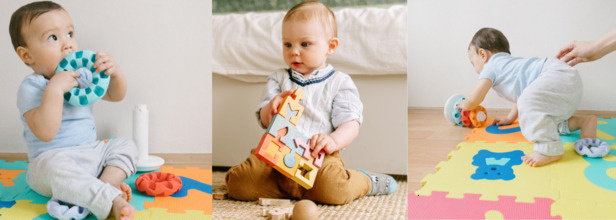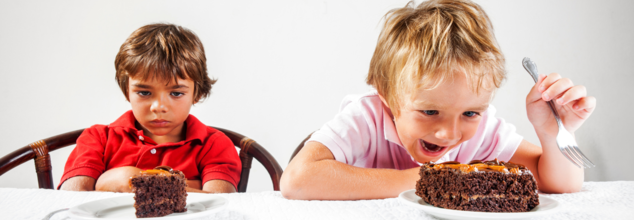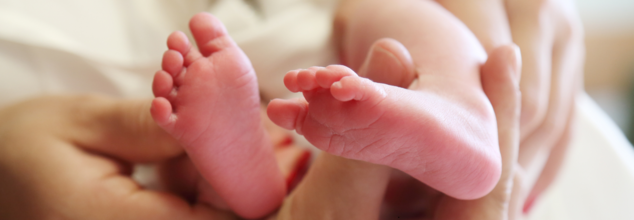- Health Conditions A-Z
- Health & Wellness
- Nutrition
- Fitness
- Health News
- Ayurveda
- Videos
- Medicine A-Z
- Parenting
- Web Stories

Credits: Canva
What Is The Leap 6 In Babies?
Your baby is growing, learning new tricks, but suddenly you see some developmental regression? Your baby who could do certain things for you is now not willing to let you go, even for a few minutes. Should this be a matter of concern? The science does not think so!
This is called Mental Leap 6. What exactly is this? Let's figure it out:
This starts around the 37th week, when the cognitive and emotional abilities develop and is progressing rapidly. This is the time when your baby is around 9 to 10 months old and is learning more skills, and the attitudes resemble those of toddler.
However, during this time, your kids emotions also come to play, and they really have no limit. There might be mood swings, jealousy, or your baby reveling against things which were otherwise smooth.
Here is what can you expect during the sixth leap
Your baby here goes through intensive cognitive and emotional development and to your baby, suddenly, a lot of things start to make sense. At this age, they will be able to categories, for instance, they would be able to tell that dogs, horses, and birds are different, but they all belong to the category of animals. Same goes for fruits, vegetables, and breads, that they are edible, when though they look different.
This is also the phase when your baby could feel jealous, when he or she sees your playing with another child, or giving attention to another baby.
What are the signs of Leap 6?
This period, since the baby is experiencing a lot of things for the first time, may increase the crying and clinging tendency of your baby. Which is why your baby needs you more than ever. The signs of leap 6 are:
Nightmares
Your baby might scream during the night or whimper in their sleep.
Developmental Regression
Some babies also experience development regression, like not being able to stay put for a few minutes without their caregivers. However, there is nothing to get worried, it only happens because they are feeling overwhelmed by these changes.
Jealousy
At this phase, emotions are easily triggered. This is because your baby is also learning about this new expressions, and does not know how to balance them.
How long does it last?
The leap 6 lasts between 3 to 6 weeks and thus makes it one of the longer leaps. This happens to all babies, though the signs and symptoms may vary. This could be a challenging period for the parents, however, it is important to deal with this phase with patience.
However, this is also the phase when you see your little one is able to stack rings and other items, explore different shapes and material, how they feel. So, even if some of it is rough, it will pass!
Does it affect sleep?
Yes, it does. This is when your baby sleeps less than before. They might have trouble sleeping, or take longer time to fall asleep. They could also experience night walking, and wake earlier in the morning. They could also either take shorter naps or boycott naps altogether.
Here are some tips to help you get through Leap 6:
- Keep your baby on age-appropriate schedule with a flexible bedtime
- Transition your baby from 3 nap to 2 nap cycle, so your baby can sleep well at night
- Provide extra comfort, ask questions to your baby to ensure your baby can talk to things to you

(Credit-Canva)
Parents Do Play Favorites - Research Finds What Is The Key To Favoritism Among Parents
While parents often claim they do not have a favorite child, sometimes their favor is evident. Sometimes it is the kid they depend on the most, other times it is the youngest kid of the family. However, is there a specific factor parents enjoy more in their kids? After analyzing factors like age, gender and behavioral pattern, researchers found what parents favored the most in their children
In a 2025 study published by the Psychological Bulletin, researchers found that parents favor daughters. They are more likely to be the favorite, across both mothers and fathers. Firstborn children also often receive more positive attention. Additionally, children who are described as conscientious – meaning they are responsible, organized, and do what they're supposed to – are also frequently favored. These findings suggest that certain personality traits and birth order can influence how parents interact with their children, even if unintentionally.
How Did They Find Parents Favored Certain Kids
Researchers looked at the results of many different studies. They combined the findings from over two dozen research papers, including articles, school projects, and large collections of data. This allowed them to see broader patterns in how parents treat their children differently. By looking at things like how much affection parents show and how they share resources, the researchers could draw more reliable conclusions than if they had just looked at one single study. This big picture approach helps us understand the common trends in parental favoritism.
Why Did The Parents Favor These Traits
Older Siblings
Parents tend to grant older children more freedom and decision-making power, likely due to perceiving them as more mature and responsible based on their age and experience. Having navigated earlier developmental stages, they've often earned more trust, leading parents to offer greater independence compared to their younger siblings who are still learning and growing.
Daughters
Social norms and potential emotional closeness might contribute to daughters being favored. Parents may have different communication styles or expectations, possibly leading to a stronger perceived bond. While conscientiousness and agreeableness play a role overall, a general inclination towards daughters could also stem from subtle societal influences on parental perceptions and interactions.
Conscientious and Agreeable Children
Children who are responsible, organized, cooperative, and kind often experience more positive parental interactions. Their agreeable nature leads to less conflict, creating smoother relationships. These traits can make parenting easier, resulting in more praise, trust, and overall favored treatment compared to siblings who may exhibit more challenging behaviors.
Avoiding Shows Of Favoritism For Kid’s Well-Being
When children feel like they are not the favorite, it can have a real impact on their well-being. It's not just about feeling a little sad; it can affect their mental health, their relationships with others, and even how well they do in school. To make sure all their children feel equally loved and valued, parents can try a few practical things.
It's helpful for parents to regularly think about how they interact with each child. Showing interest in each child's unique hobbies and asking them open-ended questions about what's important to them can make a big difference.
Spending dedicated one-on-one time with each child and avoiding comparisons between them are also key. Encouraging a positive relationship between siblings and openly talking about everyone's needs can create a more supportive and equitable family environment.

Credits: Canva
Your Daily Dose Of Sunlight Could Boost Fertility And Ovarian Health After 30
Trying to conceive in your 30s can feel like a race against time, but what if the secret to increasing your fertility was as easy as taking a walk outside for some sunlight? Yes, you heard that right! New studies indicate moderate sun exposure to have a crucial role in maintaining ovarian health and fertility, particularly for women past the age of 30. The quest for fertility and reproductive well-being assumes greater importance with advancing age for women, more so after passing the 30s. That biological functions change with age for women is not a secret, and with this comes the dip in fertility as well but what if something as easy as sunlight could improve those chances? Research indicates that moderate sunlight exposure may play a big role in ovarian health and fertility, particularly in women aged over 30.
We've known for years that sunlight improves our mood and mental health. Natural serotonin production while being exposed to sunlight is well-documented, but new studies are now connecting sunlight exposure with better fertility rates, especially among women aged over 30.
A study appearing in Steroids, authored by scientists at Tel Aviv University and the Sheba Medical Center, reveals how solar radiation exposure may impact fertility. The study, in particular, examined how sun exposure influenced the level of Anti-Müllerian Hormone (AMH) in women. AMH is an important marker of ovarian reserve—the amount of eggs a woman possesses in her ovaries, which determines her fertility potential.
The scientists followed 2,235 women aged 20 to 40 and discovered an interesting trend: women aged 30 to 40 who were exposed to moderate amounts of sunlight in spring and autumn had more AMH compared to those exposed to little sunlight in winter months. Surprisingly, those who were exposed to more solar radiation in summer had greater levels of AMH than those in the winter. Although the study does not create a direct cause-and-effect relationship, it does imply that moderate sun exposure can be good for ovarian reserve and therefore fertility.
Role of Vitamin D in Fertility
Vitamin D, or the "sunshine vitamin," is manufactured by our skin after exposure to sunlight. Vitamin D has been found to be very important for fertility, especially for women who are attempting to get pregnant. A deficiency in vitamin D has been linked to unfavorable fertility outcomes, such as lower IVF success rates and an increased risk of pregnancy complications.
For women attempting conception without medical aid, having optimal levels of vitamin D can maximize the possibility of conception. A number of studies establish that women with higher levels of vitamin D are likely to have better rates of implantation of the embryo and better success when undergoing IVF treatment. The relationship between vitamin D and fertility highlights the need to maximize exposure to sunlight or take supplements, especially for those attempting conception.
How Much Sun is Too Much?
While moderate sun exposure will improve fertility by increasing vitamin D levels and AMH levels, it's necessary to counterbalance this with the danger of too much sun. Long-term exposure to strong sunlight can cause sun damage, premature aging, and increased skin cancer risk. So, it's worth striving for safe, moderate sun exposure—usually, about 10 to 30 minutes a few times a week, depending on the type of your skin and sun intensity.
It's essential to pay attention to your body and not expose yourself to the sun during the strongest hours, usually between 10 a.m. and 4 p.m. Applying sunscreen to longer exposures and dressing in protective clothing is worth considering to avoid long-term damage to your skin.
Fertility-Enhancing Lifestyle Changes for Women Age 30 and Above
Sunlight exposure is only half the solution when it comes to enhancing fertility among women aged 30 and above. Embracing a healthy lifestyle can also contribute in a notable way to enhancing reproductive health. These are some of the most important lifestyle changes that can enhance fertility:
1. Eat a Balanced Diet
A healthy diet high in antioxidants, healthy fats, and whole foods may also contribute to improving fertility. Foods that are rich in nutrients such as folic acid, zinc, and omega-3 fatty acids play a critical role in maintaining reproductive health. Especially, consuming fruits, vegetables, lean protein, and whole grains can normalize hormones and make conception more likely.
2. Exercise Regularly, But Don't Overdo It
Physical exercise is essential for general health and fertility. Regular, moderate exercise—like walking, swimming, or yoga—can help normalize hormones, enhance blood flow, and alleviate stress. Excessive exercise, on the other hand, can have the opposite effect and harm fertility. Women who overexert themselves or have extremely low body weight can suffer from menstrual irregularities, which can prevent ovulation.
3. Stress Management
Chronic stress is a proven fertility killer, as it can cause hormonal imbalance and affect ovulation. Adding stress-reduction methods like yoga, meditation, or breathing exercises can help balance your body. Also, talking to a counselor or therapist can be helpful in resolving emotional and psychological stress that could be impacting your fertility.
4. Get Enough Sleep
Sleep is necessary for hormone balance and overall health. Lack of sleep can raise cortisol levels and interfere with your reproductive hormones. Get 7 to 9 hours of quality sleep each night to aid your fertility and overall health.
Although no one factor can promise fertility, sunlight exposure may be a natural and inexpensive means of aiding reproductive health. Along with a healthy diet, exercise on a regular basis, and stress management techniques, you can really boost your chances of conception, particularly if you're in your 30s. Fertility is a multifaceted process, and it's always a good idea to consult with a healthcare provider when changing your lifestyle or embarking on a family planning adventure.
Moderate sunlight exposure not only does your mood and mental health good but also has an unsuspected but possibly vital role to play in enhancing ovarian health and fertility beyond the age of 30.

Credits: Canva
US Fertility Rate Remains Below Levels Needed To Sustain Population Growth
The US is facing a long-term decline in the birth rates. As per experts, this raises a concern in terms of what this means for country's future, especially with regard to health of its population, economy, and caregiving systems.
A Slight Rise in 2024
As per the new data released by the US Centers for Disease Control and Prevention (CDC), more than 3.6 million babies were born in 2024. This is just a 1% increase from the previous year, which had been the lowest record in births. While this uptick may seem encouraging, it is not enough to reverse the troubling trend.
The US fertility rate remains around 1.6 births per woman. This is significantly below the 2.1 births that is required to sustain the population growth without immigration.
As per the demographers, this continuous drop began during the Great Recession in 2007. It has continued steadily since.
Shift In Teen Births
One of the biggest shifts is the steep decline in teen births. In 1991, about 62 of every 1,000 teenage girl had a child. This number has now fell to just under 13 by 2024. This is a historic low that reflects a positive shift, better education, access to contraception, and changing attitudes about early parenthood.
Similar trend is seen among women in their 20s, as the rates their too have dropped. In 2007, about 106 of every 1,000 women aged 20 to 24 gave birth. By 2024, the number has dropped to around 57. For women aged 25 to 29, the rate fell from 118 in every 1,000 women in 2007, to 91 in 2024.
Though there has been a slight rise in births among women in their 30s, experts say that it is not enough to offset the overall decline.
Are Births Being Delayed?
“One of the big questions is all these births that haven’t occurred—are they just being delayed?” asked Ken Johnson, a demographer at the University of New Hampshire. “Or are a lot of these births going to be forgone entirely?”
The answer has significant public health implications. A shrinking younger population could lead to fewer caregivers for an aging society, higher burdens on healthcare systems, and a smaller workforce contributing to national health programs like Medicare.
Why Are Fewer Americans Having Kids?
As per experts, while people still want children, there is a lingering financial burden and social barriers too that get in a way. High student loans, debt, and the rising coast of child care, unstable housing, along with limited access to paid parental leave are all major concerns.
“People don’t have kids when they don’t feel good about their own futures,” said Karen Benjamin Guzzo, a family demographer at the University of North Carolina.
Can Policies Help?
Some political leaders are proposing measures to encourage parenthood. Former President Trump, for instance, has suggested “baby bonuses” and scholarships for married couples or parents. However, Johnson believes that without stronger, systemic support, the U.S. birth rate is unlikely to bounce back to replacement level.
Immigration may help slow the effects of falling birth rates. Many immigrants move to the U.S. with plans to start families, Johnson noted. “They bring the potential for babies in the future.”
© 2024 Bennett, Coleman & Company Limited

